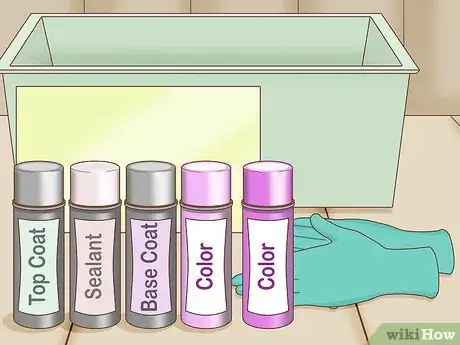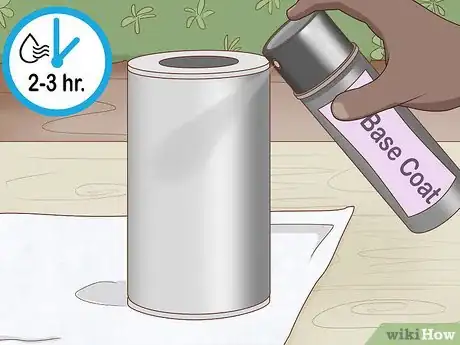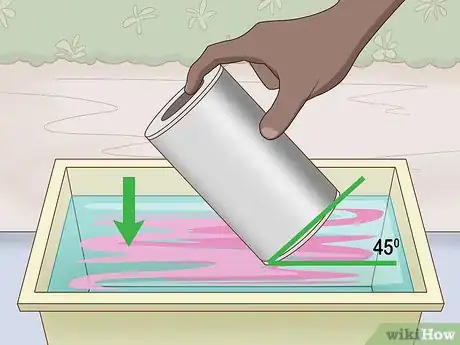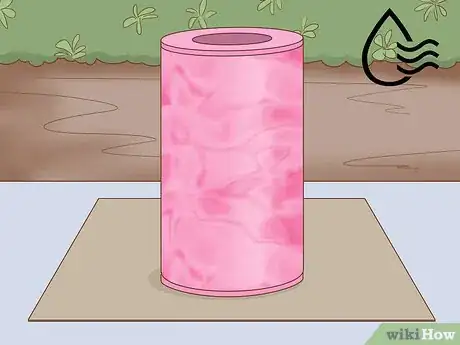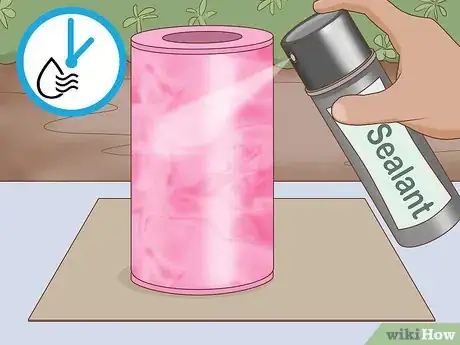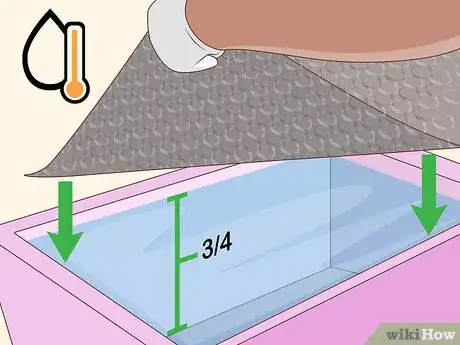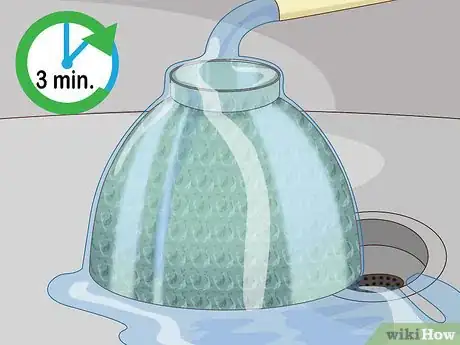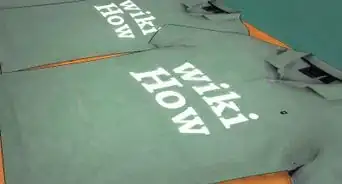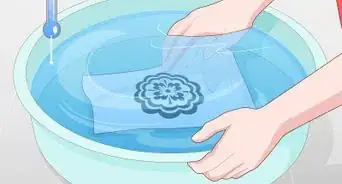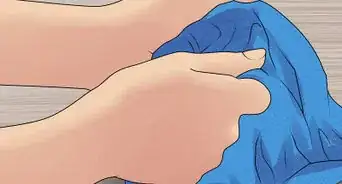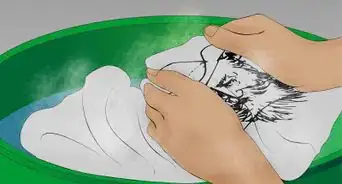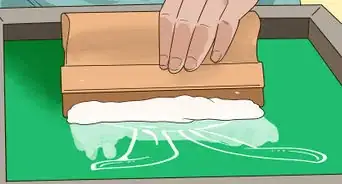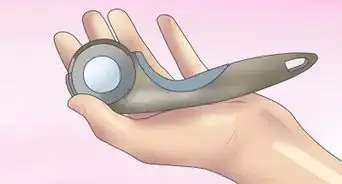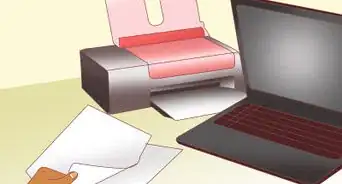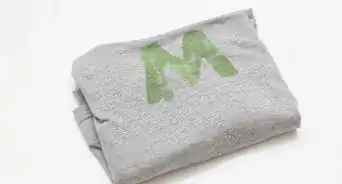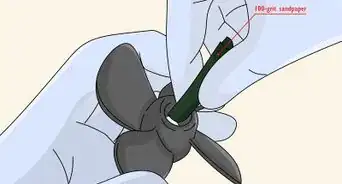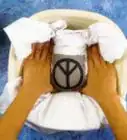This article was co-authored by Laura M. Johnson. Laura M. Johnson is a Professional Artist and the Owner of Laura Margo Murals & Custom Art in St. Paul, Minnesota. She has over five years of experience in the industry and has worked professionally across venture capital, communications, the arts, and beyond. She helps empower small and growing businesses to find their voices, share their stories, and grow their impact. Laura received her Master of Business Administration from the University of Minnesota - Carlson School of Management, and her Bachelors in Journalism and Communication Studies with a minor in Fine Arts from the University of Oregon.
This article has been viewed 369,761 times.
Hydro dipping is a fun way to decorate any 3-D item that can be submerged in water without harm. While there are many companies specializing in hydro dip art for large items (e.g. cars and sports equipment), it’s possible to do the process on your own and be creative. So if you're ready to dazzle others with your gorgeous, homemade designs, you're in luck. We're explaining the whole process in detail below. Read on for more!
Steps
Hydro Dipping with Spray Paint
-
1Gather what you need. Begin the hydro dip process by deciding what you want to paint, then pick paint colors and find a water-tight container large enough to accommodate the object. You can use one color of spray paint, or several colors to swirl into cool designs with a disposable wooden stick. Purchase spray sealant (available at art stores or hardware stores) to seal your colorful design onto the object after hydro dipping, as well as protective gloves.[1]
- The plastic container should be large enough that it won’t overflow if the object being painted is submerged in it. Buckets, large plastic storage containers, and feed tubs are all good options.
- If you do not wish to get paint on the container you are using, line it with plastic sheeting before pouring in the water.
-
2Set up the painting area. If you can, set up outdoors (e.g. in your driveway or on the lawn) to avoid having your home smell like spray paint fumes. Make sure all of the items you will need are within arm’s reach, as the process of hydro dipping can go very quickly. Fill your container about ¾ full with lukewarm or warm water, as the ideal temperature for spray paint is between 50 and 90 degrees Fahrenheit (approximately 10 to 32 degrees Celsius).[2]
- If you have to set up indoors, open as many windows and doors as possible and nearby furniture with plastic sheeting.
- Make sure to keep children and pets away from the area while you paint.
Advertisement -
3Apply a base coat. In the event that certain spots on the object do not get covered in paint when you dip it, apply a base coat color that will show through. Use spray paint to coat the entire surface of the object. Let it dry for 2-3 hours before you start the hydro dip process.[3]
-
4Spray paint onto the water’s surface. Make sure to shake the spray paint cans thoroughly to mix the paint before applying it. Hold the can 10 to 12 inches (approximately 25-30 cm) from the surface of the water and spray it to your heart’s content until the surface is coated. Switch between colors as desired to make your own unique creation.[4]
- Colors will swirl together naturally on the water’s surface. To make smaller swirls, use a clean wooden stick to stir the colors until you’re left with a design you like.
-
5Dip the object in the container of paint and water. Put on gloves and make sure that the object you are painting is free of dust or debris. Slowly dip it into the container until it is fully submerged. Slowly pull the object back out of the water.[5]
- If you do not wish for the object you dipped to receive a second coat of paint on its way out of the water (which might alter the original swirl pattern of the paint), part the paint on the water’s surface before pulling the object out of the container. Having a second person to help you would be a big help for this step!
-
6Leave the object to dry. Place the painted object on a plastic sheet or piece of cardboard to air dry. To make sure it is completely dry, let it sit for several hours before touching it. If you leave the object indoors to dry, make sure it is left somewhere safe where children or pets will not have access to it.[6]
-
7Use a clear, spray sealant. To keep your hydro dip paint looking fresh and clean, spray it with a clear spray sealant (available in hardware stores in matte, semi-gloss, or gloss finish). Spray an even coat over the object and let it dry for several hours. Apply the sealant only after the object is completely dry.[7]
Using a Hydro Dipping Kit
-
1Purchase a kit. Look online for home hydro dip kits, which allow you to transfer a specific print or design onto a 3-D object (that can be submerged in water without harm) without specialized equipment. In general, companies making these kits will offer an assortment of designs to choose from to customize your kit. Basic home hydro dip kits should include:
- Patterned film
- Activator
- Top coat
- Basecoat
- Universal primer
-
2Choose a suitable container. Most DIY kits will not come with a container to use during the dipping process. Choose a watertight plastic, glass, or aluminum container that is deep enough to fully submerge the object you are hydro dipping. It should also be long and wide enough to leave 5-6 inches (approximately 12-15 cm) between the edge of the container and the object.
-
3Prepare the item. Make sure that the item you are dipping is free of dust and debris. Spray the item with the primer provided in your kit, enough to coat it but not enough for the primer to run. Apply 1-2 light coats of the base coat spray provided in your kit, and leave the item to dry for one or two hours.[8]
- Before applying the primer and base coat, use masking tape to block off any parts of the item that you do not wish to have an image printed on.
- Do not skip using primer––it helps the image to adhere properly to the surface, making the final product durable and long-lasting.
-
4Size and cut the film. Measure the size of the object you wish to cover and add 4-5 inches (approximately 12-15 cm) on each side. Cut the film accordingly. Make sure that the film remains dry during this process, as getting it wet could cause the image to warp.[9]
- Place masking tape around the edges of the film to keep it from rolling.
-
5Set up the container. Fill the container with hot (but not boiling) water, approximately ¾ of the way full. Carefully pick up the film and bring the opposite sides together, holding it like a sling. Place the bottom of the sling onto the middle of the surface of the water, and slowly bring the sides down to place the film flat on the water. [10]
-
6Let the film hydrate and apply the activator. Use your phone or a stopwatch to ensure that the film dissolves for sixty seconds. After sixty seconds, spray the activator provided in your kit evenly over the film. Once coated, the film should take approximately 5-10 seconds to turn into liquid ink on the surface of the water. [11]
- When the film is fully activated it will have a distinctly glossy appearance and will expand to fill the entire surface size of the container.
-
7Dip your item. Hold your item at a 45-degree angle and slowly submerge it into the water. Once the item is fully submerged, even out the angle by pushing it down towards the ink. Keep your movements fluid for best results.[12]
- Put on gloves before dipping your item. If they are not supplied in the kit, purchase a pair before starting the whole dipping process.
-
8Rinse the item. Slowly remove the item from the water. Hold the item lightly and carefully, and avoid rubbing its surface. Rinse it under cold water immediately for approximately 3 minutes to remove any PVA residue.[13]
-
9Apply the top coat. After air-drying the item, apply an even coat of the aerosol top coat spray provided in your kit. Let the item air dry before applying a second coat. Continue the process until the finish is to your liking.[14]
Community Q&A
-
QuestionHow should I clean up the spray paint on top of the water?
 ZackTop AnswererYou can swipe the paint away with a paper towel or a similar absorbent product.
ZackTop AnswererYou can swipe the paint away with a paper towel or a similar absorbent product. -
QuestionCan I use an acrylic finisher?
 ZackTop AnswererYou can use an acrylic finish coat if the directions for the hydro dip do not contraindicate an acrylic overcoat.
ZackTop AnswererYou can use an acrylic finish coat if the directions for the hydro dip do not contraindicate an acrylic overcoat. -
QuestionEven with warm water, my spray paint starts to form a skin almost immediately, and my wooden stick gathers up the paint when I try to make a design. What am I doing wrong?
 ZackTop AnswererIt is likely that your paint is a very fast-drying paint. Try a slower-drying paint. See the can for drying times. If you paint in direct sun or very hot weather, the paint will set up too fast, so try cooler weather and shade.
ZackTop AnswererIt is likely that your paint is a very fast-drying paint. Try a slower-drying paint. See the can for drying times. If you paint in direct sun or very hot weather, the paint will set up too fast, so try cooler weather and shade.
References
- ↑ http://www.cowboyway.com/HowTo/HydroDip01.htm
- ↑ http://www.krylon.ca/how-to/safety/spray-painting-best-practices/
- ↑ http://www.cowboyway.com/HowTo/HydroDip01.htm
- ↑ http://makezine.com/2015/06/24/skill-builder-spray-paint-techniques/
- ↑ http://www.cowboyway.com/HowTo/HydroDip01.htm
- ↑ http://www.cowboyway.com/HowTo/HydroDip01.htm
- ↑ http://www.cowboyway.com/HowTo/HydroDip01.htm
- ↑ https://www.youtube.com/watch?v=NI5CgKUiEi8
- ↑ https://www.youtube.com/watch?v=NI5CgKUiEi8
About This Article
To hydro dip an object using spray paint, start by giving it a base coat and leaving it to dry for 2-3 hours. Then, fill a plastic container 3/4 full with lukewarm water and spray your chosen colors onto the surface of the water. Next, dip your object slowly into the water and bring it out again. If you only want the object to get 1 coat of paint, try separating the paint on the surface before you remove the object through the space you've created. Finally, let the object dry for several hours before spraying it with a clear sealant. For tips on how to hydro dip using a hydro dipping kit, keep reading!
